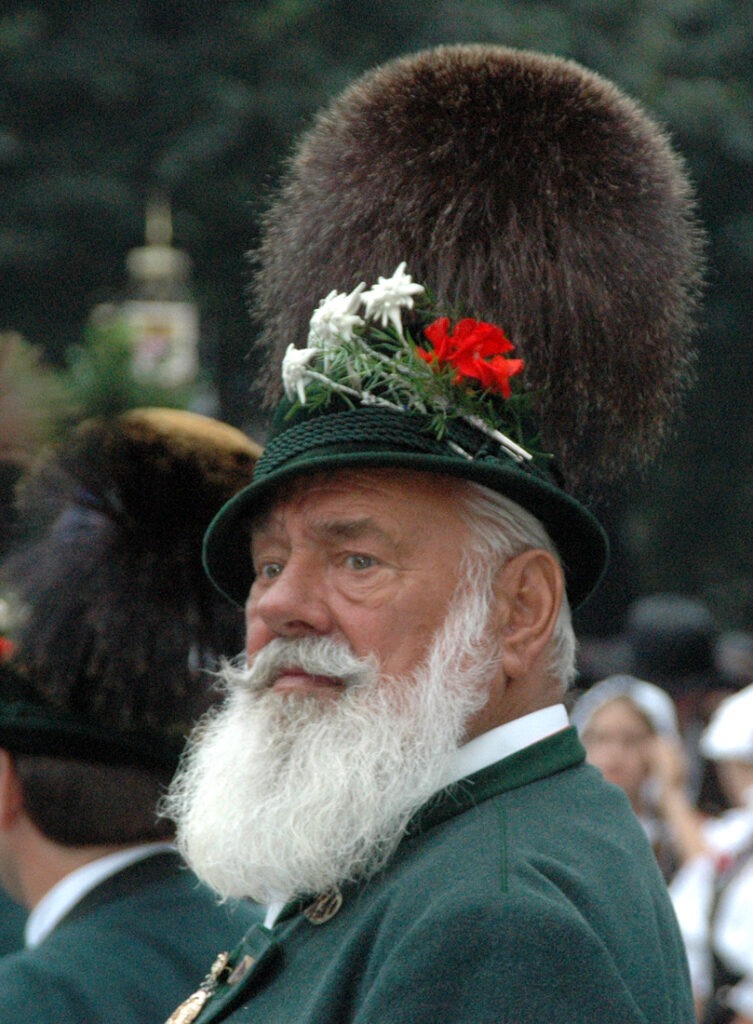Summer is over. In Germany the weather changes punctually, just like in Camelot, so on September 1st it cooled off right on schedule. But in Munich, there’s another sure way to recognize that fall has arrived. Overnight men exchange their Bermuda shorts for Lederhosen and women doff their tankinis for Dirndls. It’s Oktoberfest time again!
Locals gear up for this event by retrieving their Tracht from the basement. It’s like Halloween, except that it lasts two weeks and the choice of costume is limited. Germans need rules, after all, so the narrow definition of costumes is very willkommen. For men, that means Lederhosen that are either made of deerskin or at least look like it, a plain rough linen shirt or a cotton one with a red-and-white tablecloth pattern.
If you’re over 50 and aren’t trying to hide it, you can go all out with a hat festooned with a shaving brush just in case you notice some stubble on the road. OK, just kidding, it’s a tuft of mountain goat hair whose original purpose was to show off the wearer’s prowess as a hunter. Nowadays these pricey trinkets are more proof of deep pockets than anything else. Men also string a silver chain called a Charivari across their belly, the Bavarian version of the charm bracelet featuring boar’s teeth, silver coins, cross sections of antlers, and other trophies, further emphasizing the wearer’s Bavarianness. Charivari is also the name of a local station, and I still remember the “Aha!” moment I had upon discovering the original of the name. The Oktoberfest is the one occasion when a beer belly seems strangely fashionable.
Women can sport Lederhosen, too, but mostly wear Dirndls that are one size too small to better strut their stuff. Poof! Overnight the suffragette movement is erased from history and everyone is running around in corsets and giggling like schoolgirls. The beer helps, too. Some modern Dirndls are mini-skirts but the original ones still come down to the ankles and are of heavy linen made especially for Dirndls. It’s the one time when a grown woman can play dress-up in public and no one will bat an eye, because they’re playing dress-up, too.
Recently, tourists have gotten in on the act, too. Of course! If it’s Halloween and if an impressive mummy walks by, you want to counter that by being an equally imposing witch. The downtown pedestrian zone of Munich is lined with stores selling complete, inexpensive outfits from the felt hats with feathers for both men and women down to the clumpy Haferlschuhe, which translates as something like “coffee mug shoes” which is kind of what they look like, too.

If you’re a regular working Jane, it’s easy to forget that it’s Oktoberfest time, but you’re in for a rude awakening when you walk into a train station and find it filled with people who look like they just jumped out of a Goya painting, Mary Poppins style. On the morning trains, families pile onto the train all decked out in their Tracht, smiling in eager anticipation of the sugar-coated nuts, the rides, and the games.
In the evening it’s a different story. The women stumble onto the train platform wearing giant gingerbread hearts necklaces that say things like Mein Spatz (literally “my sparrow,” my dear) holding plastic flowers or stuffed animals that their husbands won at the shooting gallery. The kids carry shiny aluminum helium balloons. By this time the men have had so much alcohol that they feel manly, despite the fact that they are wearing short leather pants and knee socks in public as they swagger around to the best of their drunken ability.
But not all outfits are traditional. There is someone, somewhere who derives evil pleasure out of conjuring up the latest headwear fashion for each year’s Oktoberfest. This year it’s a chicken with drumsticks pointing up; if you pull a string the duck song plays and the drumsticks do the wave up and down doing the upside-down splits. In previous years it was lighted devil horns on a plastic headband and the Trinkhelm or drinking helmet is an evergreen: straws come down from the top of the hat to funnel beer into the wearer’s mouth. The average wearing time of these items is equivalent to the time when it was purchased to when the alcohol wears off.
The later it is, the drunker they get. People stand wobbly on the packed trains, laughing extra loud and shouting across the aisles at each other. Their breath reeks of beer and they munch the last of their sugar-coated almonds from a triangular checkerboard paper bag, offering them to fellow passengers. But no matter how loud or boisterous they get, nobody takes offense or gets angry. It’s all in good (hic) fun.
It’s all play-acting. Once the Wiesn is over (“meadow,” referring to the fairgrounds) everyone sends their duds to the cleaners and puts on their day clothes. The workers come back to disassemble the giant tents, rides, and concession stands and put it all in storage. Life returns to normal, until next year when the party begins again.
Brenda Arnold
Title photo by Harald Bischoff on Wikimedia Commons
